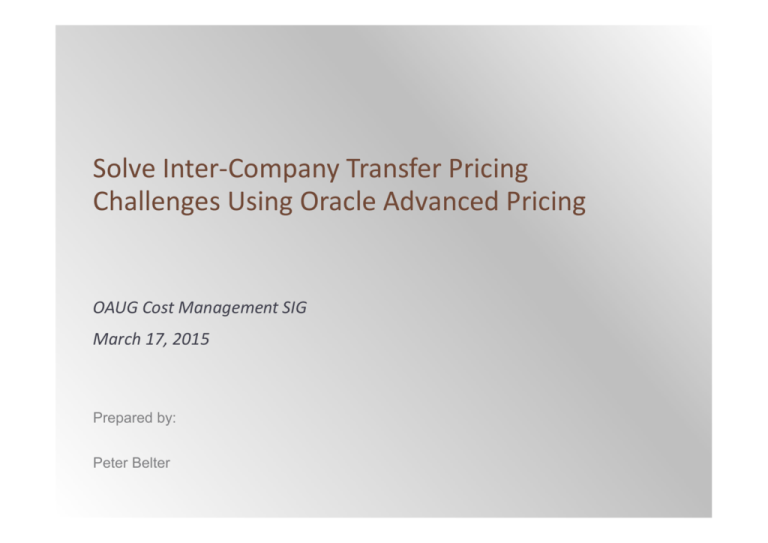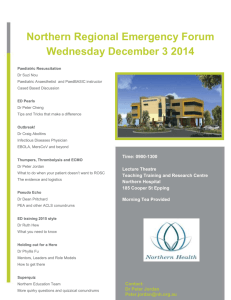
Solve Inter-Company Transfer Pricing
Challenges Using Oracle Advanced Pricing
OAUG Cost Management SIG
March 17, 2015
Prepared by:
Peter Belter
Peter Belter
Professional Summary
17 years or experience implementing, maintaining enhancing Oracle EBS Applications
Participated in 20 projects in Europe, Southeast Asia, North and South America
Creator of several unique Oracle enhancements, including More4Apps “Excel Out” a
concurrent request that takes SQL query as parameter and produces nicely formatted
Excel report
Some of my solutions are documented at www.piotrbelter.blogspot.com
Spyglass Corporate Services provides back office and administration to
businesses in the PCB industry, extending Cloud-like services coupled with
direct business management (Accounting, IT, HR).
Copyright © 2015 Peter Belter . All rights reserved
2
Learning Points
Learn how to manage transfer pricing between your domestic and
international subsidiaries
Adjust your pricing for intercompany invoicing by managing margins per
product line and subsidiary, rather than detailed item specific price list
Take advantage of different tax rates in foreign jurisdictions to manage your
tax liability
Copyright © 2015 Peter Belter . All rights reserved
3
Agenda
Overview of intercompany transaction types
Intercompany pricing practices
Setting up efficient, semi automated intercompany pricing solution
Potential tax advantages in foreign tax jurisdictions
Copyright © 2015 Peter Belter . All rights reserved
4
Intercompany Transaction Flows
Copyright © 2015 Peter Belter . All rights reserved
5
Common intercompany transaction types
Internal Requisition/ Internal Sales order (IR/ISO)
France OU requisitions material to replenish their warehouse from an US OU facility
Internal Drop Shipment
France OU sells items directly from a US warehouse
Global PO
Ireland OU purchases materials in Hong Kong to be shipped to US OU
Copyright © 2015 Peter Belter . All rights reserved
6
IR/ISO
US cost $100
Shipping
US OU
AR IC Invoice
Transfer price $125
Receiving
France OU
AP IC Invoice
Shipment
Copyright © 2015 Peter Belter . All rights reserved
7
Internal Drop Shipment
US cost $100
Shipping
US OU
AR IC Invoice
Transfer price $125
Selling
France OU
AP IC Invoice
AR Invoice $130
Shipment
Customer
Copyright © 2015 Peter Belter . All rights reserved
8
Global Procurement
AR IC Invoice
Procuring
Ireland OU
Transfer price $125
Receiving
US OU
AP IC Invoice
Purchase Order
Supplier (China)
AP Invoice $100
Shipment
Copyright © 2015 Peter Belter . All rights reserved
9
Multi-node transaction flows
Markup 0%
Markup 25%
Cost $100
AR IC price $100
Shipping
US OU
Ireland
Financial
Hub OU
AP IC price $100
AR IC price $125
Selling
France OU
AP IC price $125
Shipment
AR Invoice $130
Customer
Copyright © 2015 Peter Belter . All rights reserved
10
Intercompany Pricing Common
Practices
Copyright © 2015 Peter Belter . All rights reserved
11
Common intercompany pricing practices
Static item price list from item cost
Item costs change, new items may be added daily, old items are made
obsolete
Maintenance can become very complex
Number of
Number of Number of Total lines
subsidiaries items
price lists
2
4
6
8
10
50
10,000
20,000
20,000
50,000
100,000
250,000
2
20,000
12
240,000
30
600,000
56
2,800,000
90
9,000,000
2450 612,500,000
With extra IC node
40,000
2,880,000
18,000,000
156,800,000
810,000,000
1,500,625,000,000
12
Issues with static price lists
Virtually impossible to maintain manually, especially as new items are added on
ongoing basis
Custom maintenance programs
Pricing exceptions, primarily PPV, due to timing
Pricing exceptions due to maintenance program exceptions
Need to reconcile/fix exceptions
Need to oversee the process
Performance issues
Bottom line
Intercompany transactions are never company’s core business and should not take resources,
time and money away from other activities
13
Intercompany Pricing – Deploy and
Forget
14
How it should work
One price list with one line -> Item Price = cost
Intercompany markup set separately as a modifier, different per destination
country
Standard setup only – no customizations
No maintenance, other than the annual markup review
No exceptions due to timing or customizations
Works for all 3 major IC flows
Number of
subsidiaries
Number of Number of Total lines
items
price lists
50
250,000
50
250,000
Static Prices
2450 612,500,000
Cost based
1
1
With extra node
1,500,625,000,000
Copyright © 2015 Peter Belter . All rights reserved
1
15
List of needed setups
Shipping Networks
-
required
Intercompany Transaction Flows
-
required
Create custom responsibility for Intercompany pricing
-
optional but highly recommended for easiness of use
Profile options
-
required
Mapping cost as price, converted to transaction
currency
-
required
Create dynamic formula to calculate cost in price list
currency
-
required
Map ALL Items for IC Pricing
-
required
Create Intercompany Price list
-
required
Map additional pricing attributes
-
optional
Update INTCOM pricing entity
-
optional, highly recommended
Create Markup Modifiers
-
optional, but usually needed
Map additional qualifiers
-
optional, required if logical intercompany transaction nodes
are present
Custom pricing phases
-
optional
Copyright © 2015 Peter Belter . All rights reserved
16
Shipping Networks & Intercompany transaction
flows
The complete setup is outside of scope of this presentation
The intercompany Currency Code for IC invoice settings are executed after
the intercompany price is calculated
It is irrelevant which currency code is selected for the intercompany invoice,
all intercompany prices can be calculated using a single price list in USD
17
Custom IC pricing responsibility
The same as the existing Oracle Pricing Manager but with different profile
options
18
Profile option definition changes
Only for Oracle
installations done
before 2010
19
Responsibility level profiles
All price lists and modifiers created using this responsibility will work only
for Intercompany transactions and will not be accessible when pricing
sales orders and other customer transactions
20
Site level profiles
CST: Transfer Pricing Option - Yes, Price As Incoming Cost (read more about
other settings)
INV: Advanced Pricing for Inter-Org Transfers - Yes
INV:Advanced Pricing for Intercompany Invoice - Yes
INV: Always suffix inter-Company AP Invoice number – Yes (optional)
INV: Inter-Organization Currency Conversion – Corporate
INV: Intercompany Currency Conversion - Corporate
INV:Intercompany Invoice for Internal Orders – Yes (optional)
Copyright © 2015 Peter Belter . All rights reserved
21
Mapping cost as price, converted to transaction
currency
Create & Link new COST pricing context in the Intercompany Entity
Copyright © 2015 Peter Belter . All rights reserved
22
Mapping cost as price, converted to transaction
currency
Copyright © 2015 Peter Belter . All rights reserved
23
Mapping logic preparation
To get item cost we can use the standard API:
cst_cost_api.get_item_cost(1, inventory_item_id,
ship_from_org_id,null,null)
This would be sufficient if all of our companies were operating in single
currency. If we have warehouses storing costs in multiple currencies we
need to find the currency of the item cost using:
csd_cost_analysis_util.get_GLCurrencyCode (p_operating_unit_id)
The warehouse inherits cost currency form the set of books assigned to
the operating unit. The OU owning the warehouse can be different than
the order OU and needs to be derived:
qa_moac_pkg.derive_ou_id(p_ship_from_org_id)
Copyright © 2015 Peter Belter . All rights reserved
24
Mapping Logic
Knowing the currency code of the warehouse cost we can find
exchange rate to the IC transactional currency:
gl_currency_api.get_rate (p_from_currency,
p_to_currency, p_conversion_date, p_conversion_type)
Combining those 4 get APIS we get item cost in our currency:
Copyright © 2015 Peter Belter . All rights reserved
25
Mapping cost
Copyright © 2015 Peter Belter . All rights reserved
26
Mapping Exchange Rate
Copyright © 2015 Peter Belter . All rights reserved
27
Dynamic Pricing Formula
Cost and exchange rate are separate attributes to improve
troubleshooting transparency
Copyright © 2015 Peter Belter . All rights reserved
28
Create Intercompany Price List
Use Custom Intercompany Pricing Responsibility
Define 1 line per each base UOM
Assign formula
Copyright © 2015 Peter Belter . All rights reserved
29
Create Intercompany Markup Modifier
The modifier will apply 5% surcharge on all laptops, 4% on all other
computers and 2% for all other items
Copyright © 2015 Peter Belter . All rights reserved
30
Qualifiers
The markups will be applied when
items are transferred from US to France (group 1, IR/ISO)
or French operating unit is selling items shipped form a warehouse belonging to
the US operating unit (group 2, IC Drop Shipment)
Copyright © 2015 Peter Belter . All rights reserved
31
Summary
Intercompany transactions priced using cost based dynamic pricing
formulas:
Do not require any customizations
No maintenance other than changing markups when needed
Do not have performance issues
Derive the IC price only when the IC transaction occurs rather than calculating all possible
static combinations up front
Do not have any “hiccups” when new items are added or costs changed
Copyright © 2015 Peter Belter . All rights reserved
32
Multi node IC pricing – case study
Copyright © 2015 Peter Belter . All rights reserved
33
The Business Process Background
Vision Operations has multiple subsidiaries in Europe
The main centre of European operations is located in Ireland to take
advantage of the 12.5% corporate tax rate there
France is an important source of revenue for Vision Operations
All products are manufactured in the US and shipped directly to French
customers on sales orders placed in the French OU, or shipped from US to
warehouses in France
Due to significant pricing pressure from Asian competitors, Vision has
lowered prices in France, resulting in lower margins. Prices may continue to
drop.
Vision plans to increase net profitability by lowering its overall tax liabilities
in Europe
Copyright © 2015 Peter Belter . All rights reserved
34
The Plan
Vision plans to continue shipping products directly to France, to both
customers and distribution centers, but wants to introduce a logical IC node
in its Irish European HQ, to channel some of the profits and take advantage
of lower taxation
All sales to France will logically or virtually go through Ireland, with
substantial portion of margin moved from France to Ireland
All profits in French OU are subject to 30% tax
All profits in Irish OU are subject to 12.5% tax
Copyright © 2015 Peter Belter . All rights reserved
35
Current flow, Internal Drop Shipment
US cost $100
Shipping
US OU
AR IC Invoice
Transfer price $100
Selling
France OU
AP IC Invoice
AR Invoice $130
Shipment
France OU Gross
profit = $30
Customer
US Cost
Sells to
France sells to
Profit in Tax in
Vision Gross
France
Customer
FR
FR 30% Profit
Net profit
$100
$100
$130
$30.0
$9.0
$30
$21.0
Copyright © 2015 Peter Belter . All rights reserved
36
Planned Flow
Markup 0%
Markup 25%
Cost $100
AR IC price $100
Shipping
US OU
Ireland
Financial
Hub OU
AP IC price $100
AR IC price $125
Selling
France OU
AP IC price $125
Ireland OU
Gross profit
= $25
Shipment
Customer
France OU
Gross profit
= $5
AR Invoice $130
Tax in
Tax in
Sells to
Profit
IR
Sells to
France sells to Profit
FR
Vision Gross
Ireland
in IR
Customer
in RF
US Cost
(12.5%) France
(30%) Profit
Net profit
$100
$100
$25
$3.13
$125
$130
$5.0
$1.5
$30
$25.38
Copyright © 2015 Peter Belter . All rights reserved
37
Savings
Today, total tax = $9
Tax in
Sells to
France sells to
Profit in FR
Vision Gross
France
Customer
FR
Profit
US Cost
(30%)
Net profit
$100
$100
$130
$30.0
$9.0
$30
$21.0
Tax in
Tax in
IR
FR
Sells to
Profit
Sells to
France sells to Profit
Vision Gross
US Cost
Ireland
in IR
(12.5%) France
Customer
in RF
(30%) Profit
Net profit
$100
$100
$25
$3.13
$125
$130
$5.0
$1.5
$30
$25.37
After introducing the Irish OU node, total tax = $3.13+$1.5 = $4.63
Tax liability reduced form $9 to $4.63 or roughly 50%, net profit up by 20%
No difference in delivery lead times, seamless from customer perspective
Copyright © 2015 Peter Belter . All rights reserved
38
Key Takeaways
It is possible to use the standard functionality of Oracle Advanced Pricing to
calculate complex inter-company transfer prices. With the potential to
manage total global tax liability
It can be achieved with standard setups and no customizations
Copyright © 2015 Peter Belter . All rights reserved
39
Q&A
40







